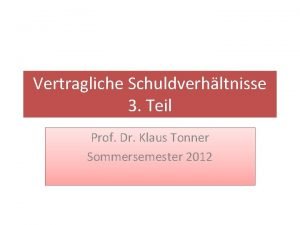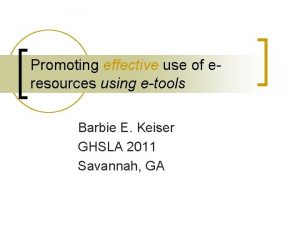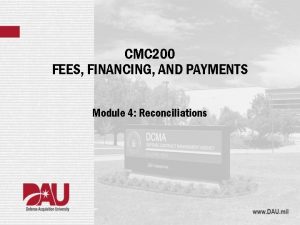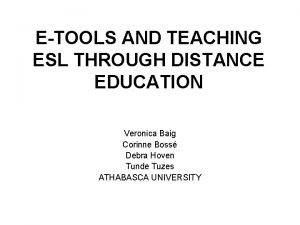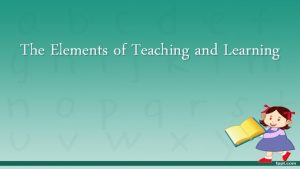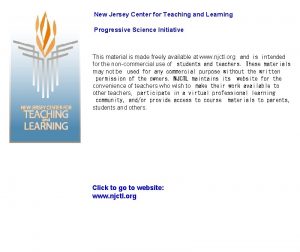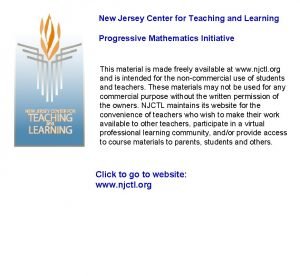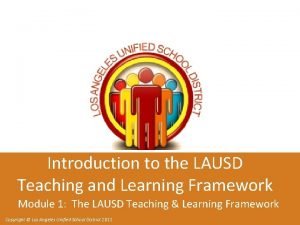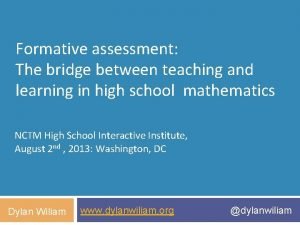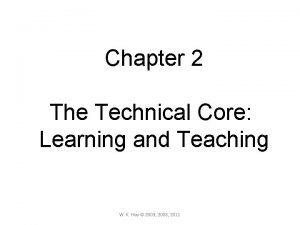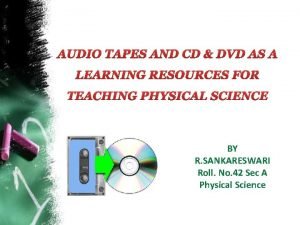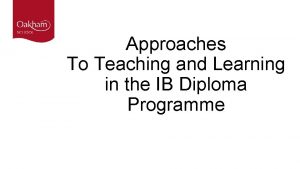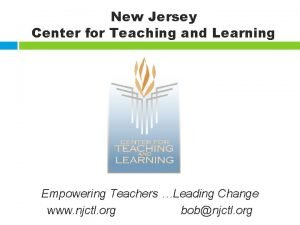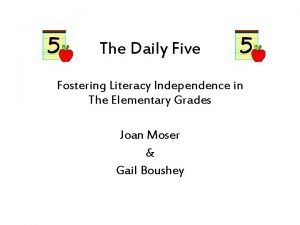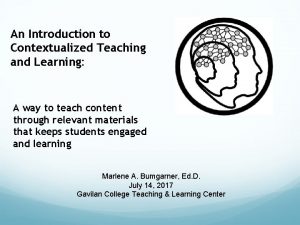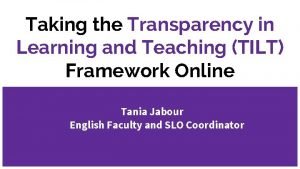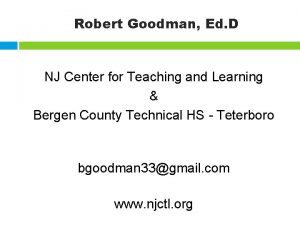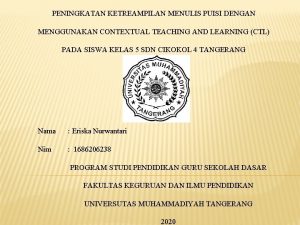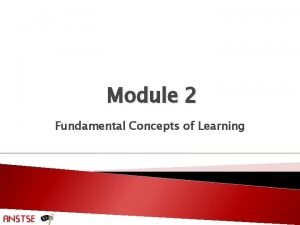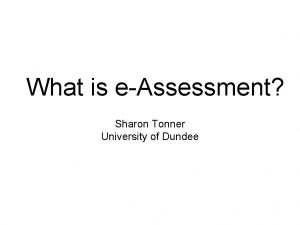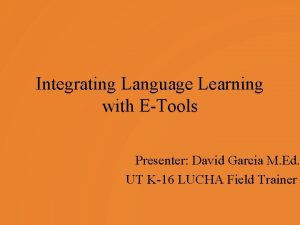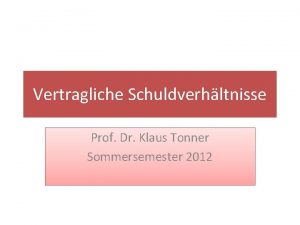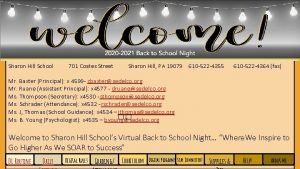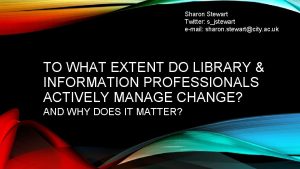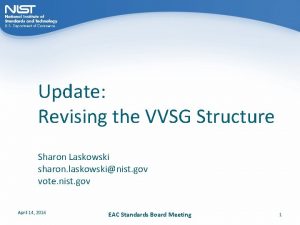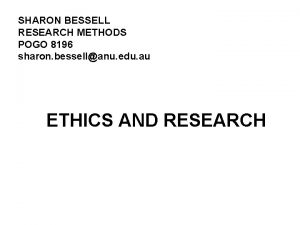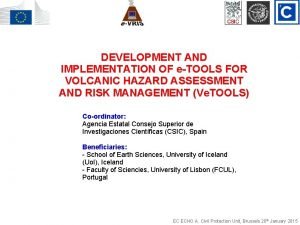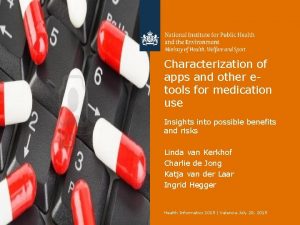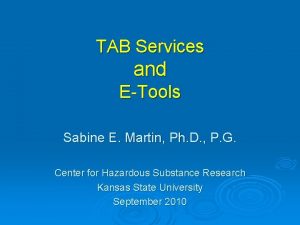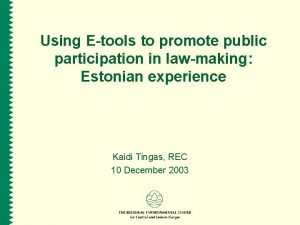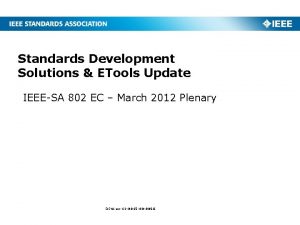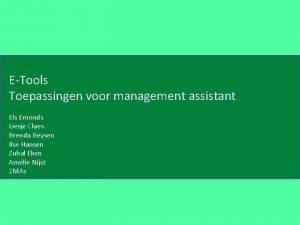eTools for Teaching and Learning Sharon Tonner Lecturer






































- Slides: 38

e-Tools for Teaching and Learning Sharon Tonner Lecturer in Primary Education (ICT) University of Dundee s. a. tonner@dundee. ac. uk

Module Overview This module will develop you knowledge and understanding of: • the importance of using e-Tools for teaching and learning; • a range of e-Tools for different pedagogical approaches; • theory that underpins the use of e-Tools in education; The module will also provide opportunities to: • a range of e-Tools; material. • reflect upon your development through engaging with the module

The. Importance Digital Generation The of using e-Tools in Education: Today's Learners LIVE and LEARN with Technology Today’s generation have been attributed a variety of labels, digital natives, net generation, google generation and millennials (Prensky, 2006; Gibbons, 2007; Hesper & Eynon, 2010) and Trilling & Fadel (2009), due to being born into era where technology has always existed. Prensky (2001; 2006), who coined the term ‘digital natives’, defined this generation of learners, born after 1980, as social beings who communicate, collaborate, create, co-create and connect using online technologies. Tapscott (2006) extends this definition by describing the ‘Net Generation’ as a networked generation whose modus operandi is networking with freedom to create and produce content online through ‘infiltered self-expression’. This ‘digital’ generation are also characterised as being proficient at multi-tasking, as claimed by Trilling & Fadel (2007), however, this is strongly refuted by Hembrooke & Gray, (2003) who found the opposite in their research where students who used computers during lectures retained less information than those students without. Watson (2010) also argued that today’s generation are competent at multi-tasking at the expense of knowledge retention.

The Digital Generation With the rapid increase of digital technologies it is undeniable that today’s generation will learn differently from previous generations resulting in a possible generation divide. Seymour Parpert (1991) warned of this ‘digital generation gap’, back in the early 1990 s, due to the way children were engaging with technology compared to adults at the time. Contrary to the arguments put forward that those born in a specific ‘age generation’ are digitally competent, there is a growing body of academic research that refutes the ‘digital native’ claim. Warschuaer (2002), for example, argues that the age generation is not a dichotomous divide but a continuum with Oblinger & Oblinger (2005) extending this argument by stating experience of technology rather than age was the main factor that contributed to a user’s competence and confidence in using technology. Other critics have warned that such assumptions about widespread digital skills among youth have not been backed up with empirical evidence (Bennett. et al. 2008). Hargittai. et al. (2008) in his research, found it was the user’s background rather than their era that was key indicator to competence in using technology. It could therefore be concluded that Buckingham’s (2007) ‘digital divide’ definition is more fitting than the ‘digital native’ claim due to the divide being people’s levels of competence in use technology across all age groups and where their level of competency lies, for example, digital pioneers, creative producers, everyday communicators and information gatherers, as defined by Green & Hannon (2007).

Task 1: Watch the following video related to today's learners. Does your teaching accommodate these learners? Digital Natives Video: http: //www. youtube. com/watch? v=_A-ZVCjf. Wf 8&feature=youtube_gdata_player Further information about digital natives can be found at: http: //www. delicious. com/satonner/digital_natives

ICT in Education: The Educator's Role Before learning about the different e-Tools that can be used in education, it is important to bear the following in mind: e-Tools should only be used: • where and when appropriate; • where it transforms methodology and offers added value to learning and teaching experiences; • Where given consideration to the pedagogy and practice of using ICT. • Educators therefore need to: • Be creative and innovative; • Use the technology of today's generation; • Develop their confidence and competence in using technology; • Take risks…. don’t be afraid to try new things out!

What this module will address to enable educators to use e-Tool to facilitate teaching and learning. There are many pedagogical approaches using online and mobile technologies that enable student engagement and collaboration, for example, the use of e-Teaching and e-Learning tools using stand-alone technologies or in some cases, mobile technologies for: • questioning and gathering student feedback during lectures using: Poll Everywhere, Twitter, Turning Point, etc; • gathering student feedback or data after lectures using: Google. Docs, Pool Everywhere, Wordle, etc; • discussion and feedback before or after face-to-face learning using: Forums in Virtual Learning Environments (VLEs), Blogs. Facebook; • student feedback or collaborative ideas using: Wallwisher, Voicethread, Google. Docs, etc; • collaborative working using: Wikis, Google. Docs, Mindmaps, etc; Each of the above online technologies will be explored throughout this module looking at the pedagogy, technology and examples.

Task 2: Short reading First, to develop a deeper understanding of online technologies read the following article: Berg, S. (2010). Web 2. 0 technologies in higher education. Teaching: A practical introduction. Kentucky Journal of Excellence in Teaching in Higher Education. Vol 8 (2) 20 -27. Article available at: http: //encompass. eku. edu/kjectl/vol 8/iss 1/2/

e-Tools: Questioning and gathering student feedback during lectures using; Poll Everywhere, Twitter, Turning Point, etc. Poll Everywhere is an online question and response application that allows lecturers to post questions to students during a lecture scenario and receive live feedback through students using portable devices that have internet capability. Poll Everywhere is free for audiences of thirty people of less with paid plans for Higher Education. Why use Poll Everywhere? Poll Everywhere enables all students to participate in lecture discussions using their own portable devices to send their response or question to the presenter. Students can contribute to discussions anonymously or authored and access the responses after the lecture rather than rely on the auditory memory. Lecturers are able to engage a larger proportion of students in discussions and use the technology as a tool formative assessment where they can feedback to students' immediate needs during the lecture. The following Top Ten reasons for using Poll Everywhere with students in Higher Education was generated from some of the responses provided by Primary Education students after using the technology during lectures.

e_Tools: Questioning and gathering student feedback during lectures using; Poll Everywhere, Twitter, Turning Point, etc. Student Top Ten Reasons for using Poll Everywhere: • To engage students in the learning environment. • To enable all students' views to be heard rather than the lone voice in the crowd. • To enable students to contribute synchronously to the learning conversation. • To allow students to access discussions and ideas after lectures. • To assess students’ understandings of a concept formatively. • To enable students’ to summarise their understanding of learning in a limited number of characters. • To make lectures/ workshops interactive through students responding using mobile devices that have internet accessibility. • To allow lecturers to adapt their inputs, during the lecture, in response to student feedback. • To make inputs participatory rather than passive. The above responses were http: //www. polleverywhere. com/free_text_polls/LTE 5 OTEw. NTM 1 NTA taken from:

Task 3: Learn how to use Poll Everywhere by creating a poll. First, watch this short video clip to develop an understanding of what Poll Everywhere can do: http: //www. youtube. com/watch? v=z. ZWM 2 -4 Jf 4 k&feature=youtube_gdata_player Next, go to Poll Everywhere (http: //www. polleverywhere. com/) and create your first poll. You may wish to create and account then text your poll.

Other e-Tools for questioning and gathering student feedback during lectures. There are other response systems that can be used to gather feedback from students during lectures, for example, Turning Point (http: //www. turningtechnologies. co. uk/), SMART Response System (http: //smarttech. com/response ) You can find out more about audience response systems at: http: //en. wikipedia. org/wiki/Audience_response Twitter can also be used to gather immediate feedback during lectures by setting a hastag that students would use to share their responses and ideas. More about using. . . LINK and TWITTER article. You may wish to read more about using response systems in education from the following academic papers: Cadwell, J. E. (2007). Clickers in the large classroom. Current research and best-practice tips. Life Sciences Education. (6) 9 -20. Gachago, D. , Morris, A. & Simon, Edwin. (2011). Engagement levels in a graphic design clicker class: Students perceptions around attention, participation and peer learning. Journal of Information Technology Education. Vol 10 253 -268. Fitzpatrick, K. A. , Finn, K, E. & Campisi, J. Effect of personal response systems on student perception and academic performance in cources in a health sciences curriculum. Advances in Physiological Education. Vol 35 280 -289.

Task 4: Read some of the following articles. Reflect upon these articles and summarise the key points you have taken from them. Share this summarised reflection with others at the following shared Poll: Submit your response by going to: www. pollev. com If using a computer you need to type the code 15305 in the box then your response. Remember to place a space after the code. The above applies for using a mobile device. You can view all responses at to the poll at: http: //www. polleverywhere. com/free_text_polls/LTM 2 Nz. Iz. MDgx. OQ

e-Tools: Gathering student feedback after lectures using: Google. Docs, Poll Everywhere, Wordle, etc. Poll Everywhere has already been discussed and Google Docs will be explored later in the module. At the present it is worth bearing in mind that the Form application in Google. Docs can be used to gather feedback or data. The link to the following video will provide further information of how Google. Docs Forms work: http: //www. youtube. com/watch? v=Izga. UOW 6 GIs&feature=youtube_gdata_player

Wordle The adage, ‘A picture is worth a thousand words’ refers to the notion that complex ideas or large amounts of data can be quickly understood through presenting the information visually. The practice of information visualisation can be traced from cave drawings and Egyptian hieroglyphs to our current digital visual representations. One relatively new form of digital information visualisation is a tag-cloud: a visual representation of textual data. What is Wordle? Wordle is a simple-to-use online software tool for generating ‘word clouds’ from text that you provide. The clouds give greater prominence to words that appear more frequently in the source text. You can customise your clouds with different fonts, layouts, and colour schemes. The images you create with Wordle are yours to use however you like. You can print them out, or save them to the Wordle gallery to share with others. Why use Wordle? A Wordle can summarise digital text, a journal or an essay, to provide a visual representation of the key words associated with the text. These visual representations can then be used to introduce or summarise the key points pertaining to a new concept, a student’s essay or ideas generated from a group of learners.

Wordle Examples of using Wordle: Primary Education students collaborative brainstorming of what 'Creativity' means: http: //www. wordle. net/show/wrdl/3944303/creativity_SAT Analysing the key words from a textual prose: Rome and Juliet: http: //www. wordle. net/show/wrdl/262806/Romeo_and_Juliet Analysing questionnaire responses: http: //www. wordle. net/show/wrdl/262894/Survey_Responses Analysing an essay: http: //www. wordle. net/show/wrdl/259712/World_War_I_Essay

Wordle Ten ideas for using Wordle in Higher Education The following list was based on responses by Primary Student Teachers: • Paste the URL from a discussion forum to discover the key vocabulary used • Paste information from a news article to find key elements • Use a Wordle based on the lyrics of a song or words of a poem to promote discussion on the main themes • Enter respondents’ word associations to test links between concepts and ideas • See how themes of a book change by entering each chapter and comparing results • Enter feedback from students to find reoccurring language (see example) • Copy an essay into Wordle to test whethere is a balance of arguments • Ask students to brainstorm what they know about a topic to formatively assess their knowledge • Use a Wordle based on a text to formatively assess students’ understanding of key terms near the end of a topic • Process responses to a question to assess common incorrect answers

Task 5: Create a Wordle First watch this short video about how to create http: //www. youtube. com/watch? v=bp. VXq 0 koi 1 U&feature=youtube_gdata_player a Wordle: Next create a Wordle at: http: //www. wordle. net/ Use the following text to create a Wordke related to e_tools (you can use your own words but remember the word that is repeated most will appear larger than others. Social_Media, Social_Media, Social_Media, Web_2. 0, Web_2. 0, Wordle, Web_2. 0, Wordle, Polleverywhere, Polleverywhere, blog, blog, wiki, twitter, twitter, facebook, facebook, facebook Finally, reflect upon how you could use Wordle for teaching and learning. You may wish to explore more how Wordle can be used in education by reading some of the links provided at: http: //www. delicious. com/satonner/wordle

e-Tools for discussion and feedback before or after face-to-face learning using: Forums in Virtual Learning Environments (VLEs), Blogs, Facebook, etc. This part of the module requires explores how Forums in Virtual Learning Environments (VLEs) can be used to gather feedback from students before or after face-to-face lectures. It should be noted that VLEs will be discussed in more depth later in the module. Blogs and wikis will also be explored to develop an understand of their potential as a tool for feedback.

e-Tools for discussion and feedback before or after face-to-face learning using: Forums in Virtual Learning Environments (VLEs), Blogs, Facebook; Forums in Virtual Learning Environments: Prior to discussing how Forums can be used as a tool for feedback and discussion, a brief explanation of what a VLE is required since this is the space where a Forum can be found. A virtual learning environment (VLE) is an education system based on the Web that models conventional realworld education by integrating a set of equivalent virtual concepts for tests, homework, classes, classrooms, and the like, and perhaps even museums and other external academic resources. It normally uses Web 2. 0 tools for 2 -way interaction, and includes a content management system. Virtual learning environments are the basic component of contemporary distance learning, but can also be integrated with a physical learning environment; this is sometimes referred to as Blended Learning. (Wikipedia: http: //en. wikipedia. org/wiki/Virtual_learning_environment). A forum in a VLE allows tutors to set up an area for discussion. As the word forum implies, it is a place where everyone has a voice to be heard and what they have to say is of value. Forums can also be used to gather feedback from students related to a specific topic. The beauty of a forum is that all posts can be viewed which can lead to a healthy debate.

e-Tools for discussion and feedback before or after face-to-face learning using: Forums in Virtual Learning Environments (VLEs), Blogs, Facebook; The use of Facebook in Education: Similar to Forums, Facebook allows a message to be sent to a year group for comments and discussion. The Facebook space can be public or private depending on the nature of the information that will be shared. Facebook is used widely by many out with education with educators preferring to use traditional online tools like VLEs. Times are changing and there are tutors who are using the tools that learners use rather than impose another tool onto them. The following blog provides an insight how Facebook can be used in education through various research articles. There are other articles on this blog that relate to using technology in education. http: //socialnetworkandeducation. wordpress. com/facebook-social-integration-informal-learning-at-university/

e-Tools for discussion and feedback before or after face-to-face learning using: Forums in Virtual Learning Environments (VLEs), Blogs, Facebook; Blogs are excellent tools for feedback and discussion. Originally conceived of as a personal online diary the weblog allows the owner to post items that are stamped by the time of their creation and with keywords chosen by the author. In this sense it is a tool to aid self-reflection or evaluation Items or posts are usually, but always, quite short and may be linked to other items through hyperlinks, keywords or shared taxonomies or bookmarks such as Digg, Reddit or Delicious. Each item in the blog can usually be commented upon and this opens up the possibility of discussion around a topic. This is one way in which collaboration can take place. One pupil posts and the others comment. Another way is to have multiple owners/authors of a blog. Blogs are implicitly public as they are posted on the web. Teachers, and pupils, can usually restrict access through a range of means – hiding the blog from search engines, named access only, passwords, etc. Trainees should consider a range of blogging environments and evaluate them for privacy and safety. Becta provide a set of guidelines on their safe and acceptable use. Files may be attached to blog posts and so they provide a simple example of a personal e-portfolio Read the following paper to develop a deeper understanding of the potential of blogs in Higher Education: http: //eprints. qut. edu. au/13066/1/13066. pdf

Task 6: Creating a Reflective Blog You task is to create a blog using blogger. com. Once you have created your blog you should write a reflective post related to what you have learnt in this module so far. It may be helpful to think about: What was your previous experience of teaching or learning with the e-Tools. This may be limited or extensive. Which tools do you think you could use in your teaching and how would you use these. Which tools do you feel you would not use. Justify why not. http: //www. coxandforkum. com/archives/000107. html

e-Tools for student feedback or collaborative ideas using: Wallwisher, Voicethread, Google. Docs, etc. Today’s generation of learners are social beings who communicate, collaborate, create, co-create and connect using online technologies. This Net Generation, or Net Gens as Tapscott (2008) defines them, are a generation whose modus operandi is networking where they can let their voices be heard in the crowd. They want to be active learners rather than consumers of information. Wallwisheris a collaborative tool that lets students be prosumers rather consumers. What is Wallwisher? Wallwisher is an Internet application that allows students to post their thoughts on a common topic using electronic sticky notes on a shared digital wall. Students can type a maximum of 160 characters per electronic sticky note that can incorporate an image, audio or video using the appropriate web address link. Why use Wallwisher? Wallwisher provides a collaborative area online where students can contribute to learning anonymously or authored. Students’ contributions can be made synchronously (during lecture inputs) and displayed immediately to the whole cohort or asynchronously (anytime, anyplace, anywhere) with the added bonus of students being able to access the collaborative area after the input to assimilate the information gathered.

e-Tools for student feedback or collaborative ideas using: Wallwisher, Voicethread, Google. Docs, etc. The following Top Ten reasons for using Wallwisher with students in Higher Education was taken from students and educators around the world who responded to a tweet on Twitter where they placed their responses on a collaborative wall at: http: //www. wallwisher. com/wall/University Top Ten Reasons: • To allow students to participate in a collaborative conversation. • To brainstorm an idea. • To allow students to access discussions and ideas after lectures. • To provide an interactive area that incorporates text, audio and visual materials. • To assess students’ understandings of a concept formatively. • To enable students’ to summarise their understanding of learning in a limited number of characters. • To make lectures/ workshops interactive through students responding using mobile devices that have internet accessibility. • To allow lecturers to adapt their inputs in response to student feedback. • To make inputs participatory rather than passive. • To allow students to contribute synchronously or asynchronously to the learning conversation.

e-Tools for student feedback or collaborative ideas using: Wallwisher, Voicethread, Google. Docs, etc. Voicethread : http: //voicethread. com / What is Voicethread: With Voice. Thread, group conversations are collected and shared in one place from anywhere in the world. All with no software to install. A Voice. Thread is a collaborative, multimedia slide show that holds images, documents, and videos and allows people to navigate slides and leave comments in 5 ways - using voice (with a mic or telephone), text, audio file, or video (via a webcam). Share a Voice. Thread with friends, students, and colleagues for them to record comments too. Users can doodle while commenting, use multiple identities, and pick which comments are shown through moderation. Voice. Threads can even be embedded to show and receive comments on other websites and exported to MP 3 players or DVDs to play as archival movies . More information can be found at: http: //net. educause. edu/ir/library/pdf/ELI 7050. pdf

e-Tools for student feedback or collaborative ideas using: Wallwisher, Voicethread, Google. Docs, etc. IMGE GOOGLE DOCS Online collaborative areas can 'encourage students to be communication and producers of knowledge and opinions rather than only recipients of information' (Renninger, 2002. p 106). Google. Docs provides a collaborative platform where all students can share their knowledge and ideas in a shared area or can work together in groups to create group presentations or documents. What is Google Docs? Google Docs is a free web-based area that provides a platform to create, store and share a variety of documents: word processing, spreadsheet, presentation, forms and drawings. Each type of document allows users to create and edit the same document online in real-time with other users. The following video provides a brief overview of the collaborative potential of Google Docs: V IDDO Why use Google Docs? Google Docs is a powerful collaborative area to enable the management and organisation of collaborative learning to occur in one shared place where users can interact with the same documents to share ideas rather than send the same document back and forward via email. It allows students to work on the same document synchronously (at the same time) or asynchronously (at a different time) to enable collaborative working and knowledge construction. When managing and organising learning it is easier to create one shared document where contributors can type their name or option beside the event or action they wish to attend or support. The benefit of this method to the traditional email method is that the organiser is freed from dealing with the influx of emails and lets the Google Doc manage the responses.

e-Tools for student feedback or collaborative ideas using: Wallwisher, Voicethread, Google. Docs, etc. Examples of using Google Docs: Creating a collaborative Word document related to Handheld Learning in Education with each student focussing on a specific aspect: https: //docs. google. com/document/d/1 Pq 9 st. Ua 3 WKg. Hh. Mic. QTX 0 Zk. O 8 wua. Av. OXBEUi. Ph. We. Mg. Q 0/e dit? hl=en&authkey=COu. Y 9 f 0 D Using Google Doc Spreadsheets to collate students' ideas across two Programmes: https: //spreadsheets. google. com/ccc? key=0 Ap. G 0 O 9 ZMxnv. Ed. G 1 w. Z 2 It. Q 1 N 1 Sm. VOUm. Zm. Tkpva 3 FZ Unc&hl=en Using Google Doc Power. Point to create together: https: //docs. google. com/present/edit? id=0 AZG 0 O 9 ZMxnv. EZHdtcj. Vm. Y 183 MWNja 2 tk. ZGRt&hl=en_G B&authkey=CLec 9 Z 0 N A place to share knowledge with the crowds rather than store in 'My Documents'. Students are able to generate ideas and share these with others. This can provide a source of inspiration. Provides an instantly accessible point of information and ideas that won't be lost if you have a computer issue.

e-Tools for student feedback or collaborative ideas using: Wallwisher, Voicethread, Google. Docs, etc. Top Ten Reasons: • Not restricted to working in same location and at same time. • Can work together in real-time and use the chat tool to discuss aspects and the main document to create. • Tutors can have an overview of progressing work and involvement in group planning for self-directed tasks • Makes managing and organising students' responses easier. • Small groups can work together to create collaborative Power. Point with all members contributing at the same time or in different locations and time. • A private copy can also be made and annotated or adjusted to suit the needs of the individual. • Many users can create presentations together; this can include involving other professionals out with the institution. • Create questionnaires and send link to students. Responses all stored in one area rather than using a different tool. • A place to share knowledge with the crowds rather than store in 'My Documents'. Students are able to generate ideas and share these with others. This can provide a source of inspiration. • Provides an instantly accessible point of information and ideas that won't be lost if you have a computer issue.

Task 7: Reflective Blog Post You should now reflect upon how e-Tools can be used for collaborative ideas or discussion/feedback. Write a reflective post in your blog.

e-Tools for collaborative working using: Wikis, Google. Docs, Mindmaps, etc; What is a wiki? 'Wiki' is Hawaiian for quick in that they are designed to enable quick and easy content: generation; collaboration; distribution. 'Wikis are collaborative websites now commonly used as a way for multiple users to create content or share knowledge online. Wikis can be publicly available website that allow anyone to edit their content, such as Wikipedia, the web-based Encyclopedia. Alternatively, they can be set up with smaller learning and workplace environments, to allow a specific set of contributors to pool their knowledge' (Donelan, 2010: 85). Why use a wiki? • Wikis enable knowledge management by: • capturing knowledge from those who have it; • converting knowledge into an explicitly available format; • connecting those who want knowledge with those who have it; • linking knowledge to knowledge; • converting individual knowledge to communal knowledge.

e-Tools for collaborative working using: Wikis, Google. Docs, Mindmaps, etc; WIKIS Communication and collaboration online falls under two main categories: asynchronous (at a different time) and synchronous (at the same time) communication technologies. Alongside these two categories are other key aspects that need to be taken into consideration when using online collaborative environments: location of participants - same place or different; number of participants - one-to-one, one-to many or group discussion; publishing to public or private audience. Wikis fall under the category of asynchronous collaborative online tools where participants can use a shared online area to create, share and disseminate their knowledge to a wider audience.

e-Tools for collaborative working using: Wikis, Google. Docs, Mindmaps, etc. Some reasons to use wikis in education can be read at Sharon Tonner's blog: http: //tecnoteacher. blogspot. fr/search/label/wikis A short visual representation of why to use a wiki: http: //www. youtube. com/watch? v=-dn. L 00 Tdm. LY&feature=youtube_gdata_player Examples of using wikis in Education: Deliver course material - Web based Communication: http: //coollessons. wikispaces. com/Web-based_Communication Share learning - University of Dundee - Student Primary Teachers: http: //technologies-ict. wikispaces. com/home High School Dundee - Primary Children: http: //juniorschool. wikispaces. com/home Collaborate with other globally - Voices of the World: http: //votw. wikispaces. com/home Collaborate and create - Student Teachers: http: //ictmoviemaker. wikispaces. com/home / Radio. High: http: //radiohigh. wikispaces. com/home

e-Tools for collaborative working using: Wikis, Google. Docs, Mindmaps, etc. A Mind Map is a highly effective way of assimilating external information, in the format of symbols, words, colours and images, into the brain's memory system. A Mind Map also works the opposite way by enabling internal thoughts and information to be transferred into a highly organised visual diagram. Originated in the late 1960 s by Tony Buzan, Mind Maps are now used by many in all areas and stages of Education to enable users to visualise their thinking. There are many Mindmapping tools, for example, Inspiration, Bubbls. . . Mindmeister. The latter tool is what will be explained. What is mindmeister? Mindmeister is one of the array of online mind mapping tools that allows users to create, share and work collaboratively on an online mind map. The following video provides a brief overview of the potential http: //www. youtube. com/watch? v=qd. Csg. Z 8 JN 6 A&feature=youtube_gdata_player of Mindmeister: Why use mindmeister? Mindmeister provides a collaborative area online where students and lecturers can contribute to learning anonymously or authored. Students’ contributions can be made synchronously (during lecture inputs workshops) and displayed immediately to the whole cohort with the added bonus of students being able to access the collaborative area after the input to assimilate the information gathered. Students' can also use asynchronously (anytime, anyplace, anywhere) to work with peers to brainstorm a topic or concept. Alongside working collaboratively, students can use mindmeister independently using a range of portable digital devices. The following Top Ten reasons for using Mindmeister were provided by educationalists via Twitter

e-Tools for collaborative working using: Wikis, Google. Docs, Mindmaps, etc; Top Ten Reasons: • Brainstorming students ideas during lectures and workshops. • Formatively assessing what students know and need to know during lectures and workshops. • Project planning with colleagues. • Creating structure of book/chapter with colleagues. • Note taking during lectures or meetings. • Problem solving collaboratively or independently. • Event preparation with colleagues. • Creating an inclusive environment for visual learners. • Freeing restrictions of time and place through using personal mobile device to interact with mind map. • Export mind map to embed in documents and presentations. Examples of using mindmeister in Higher Education. Student primary teacher using Mindmeister to collect thoughts together regarding an assignment. http: //www. mindmeister. com/30162821 Undergraduate medical students using Mindmeister. http: //www. mindmeister. com/40635821? title=dalhousie-medical-school-educational-outcomes-for-undergraduatemedical-education

Task 8: Create a Mindmap Create a mindmap using bubbl. us Place the word 'e-Tools' at the heart of your mindmap. Create branches with information about different e-Tools and how they can be used to teaching and learning.

Task 9 - Reflective Post Reflect upon your journey throughout this module using your blog. You may wish to create individual posts. You may wish to include media in your posts (images, videos, podcasts or embedded media) What you need to reflect upon at the end of this journey: Will you use e-Tools in your teaching? Justify why you would or not use? How will you use different e-Tools? What are the advantages and disadvantages of using specific e-Tools?

References Allen, J, Potter, J, Sharp, J, and Turvey, K (2007) Primary ICT : Knowledge, Understanding and Practice Exeter: Learning Matters Armstrong A & Casement C (2000). The Child and the Machine. Maryland: Robins Lane Press. Berg, S. (2010). Web 2. 0 technologies in higher education. Teaching: A practical introduction. Kentucky Journal of Excellence in Teaching in Higher Education. Vol 8 (2) 20 -27. Buckingham, D. (2007) Beyond Technology: Children’s Learning in the Age of Digital Culture. Cornwall: Polity Press. Cadwell, J. E. (2007). Clickers in the large classroom. Current research and best-practice tips. Life Sciences Education. (6) 9 -20. Daanen, H and Facer, K. (2007). Futurelab: 2020 and beyond. Available at: http: //www. futurelab. org. uk/resources/publications-reports-articles/opening-education-reports/Opening. Education-Report 663 Accessed on: (05/06/2009) Duffty, J (2006) Primary ICT: Extending Knowledge into Practice Exeter: Learning Matters. Fitzpatrick, K. A. , Finn, K, E. & Campisi, J. Effect of personal response systems on student perception and academic performance in sources in a health sciences curriculum. Advances in Physiological Education. Vol 35 280 -289 Gachago, D. , Morris, A. & Simon, Edwin. (2011). Engagement levels in a graphic design clicker class: Students perceptions around attention, participation and peer learning. Journal of Information Technology Education. Vol 10 253 -268. Green, T. D. et al (2008). Making the most of the web in you classroom. London: Sage. Mills, S. C. (2006). Using the Internet for Active Teaching and Learning. New Jersey: Pearson. November, A. (2001). Empowering Students With Technology. New Jersey: Pearson. Prensky, M. (2006). Don’t Bother Me Mom – I’m Learning! US: Paragon House.
 Lecturer's name
Lecturer's name Klaus tonner
Klaus tonner Etools counters
Etools counters Dcma form 325
Dcma form 325 Etools for education
Etools for education Physician associate lecturer
Physician associate lecturer Spe distinguished lecturer
Spe distinguished lecturer How do you greet your teacher in the afternoon
How do you greet your teacher in the afternoon Photography lecturer
Photography lecturer Lecturer in charge
Lecturer in charge Designation lecturer
Designation lecturer Designation of lecturer
Designation of lecturer Gcwak
Gcwak Lecturer name
Lecturer name Pearson lecturer resources
Pearson lecturer resources 140000/120
140000/120 Lector vs lecturer
Lector vs lecturer Lecturer in charge
Lecturer in charge Cfa lecturer handbook
Cfa lecturer handbook Lecturer asad ali
Lecturer asad ali Microteaching meaning
Microteaching meaning Cuadro comparativo de e-learning b-learning y m-learning
Cuadro comparativo de e-learning b-learning y m-learning What are the elements of teaching and learning
What are the elements of teaching and learning New jersey center for teaching and learning
New jersey center for teaching and learning How many total squares are there
How many total squares are there Guiding principles for teaching and learning in mtb-mle
Guiding principles for teaching and learning in mtb-mle Teaching learning framework lausd
Teaching learning framework lausd Assessment the bridge between teaching and learning
Assessment the bridge between teaching and learning Technical core
Technical core Tape recorder as a teaching aid
Tape recorder as a teaching aid Approaches to learning ib
Approaches to learning ib Www.njctl.org answer key
Www.njctl.org answer key 10 steps to teaching and learning independence
10 steps to teaching and learning independence What is assure model
What is assure model What is contextualized teaching and learning
What is contextualized teaching and learning Transparency in learning and teaching
Transparency in learning and teaching Nj center for teaching and learning
Nj center for teaching and learning Contextual teaching and learning
Contextual teaching and learning Three types of learning
Three types of learning

